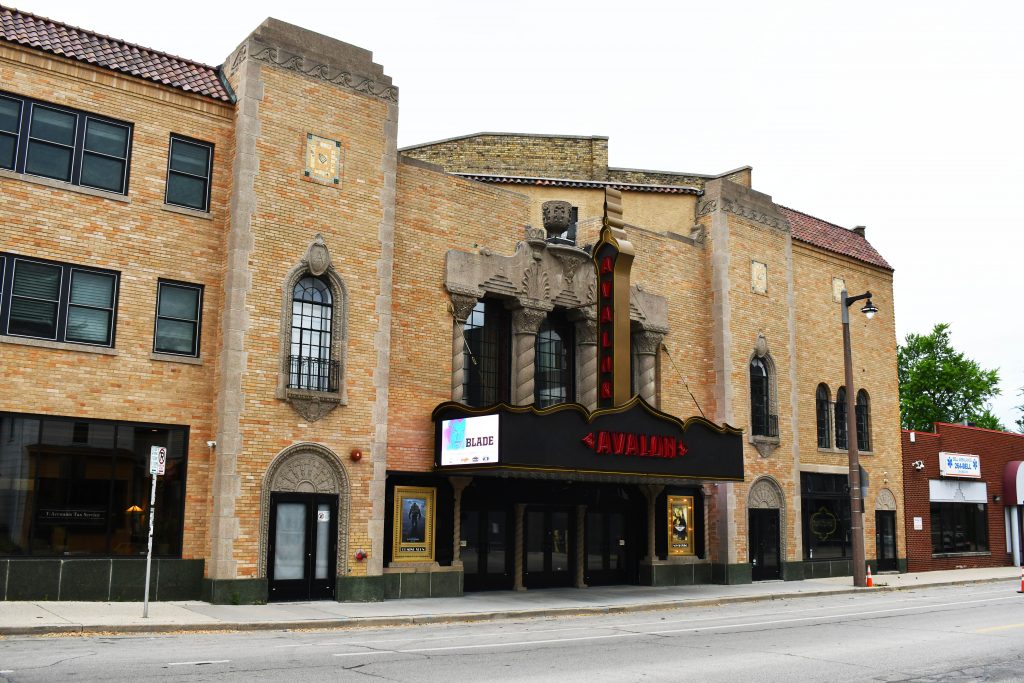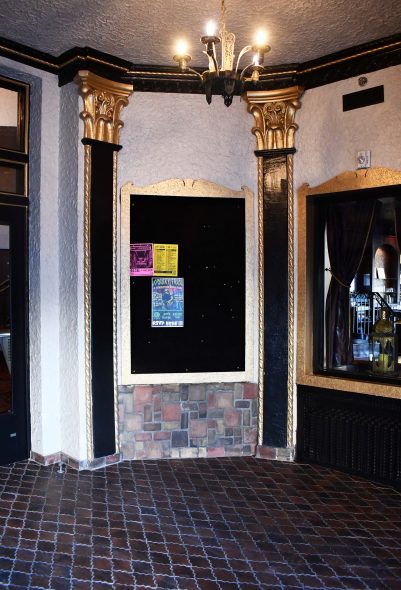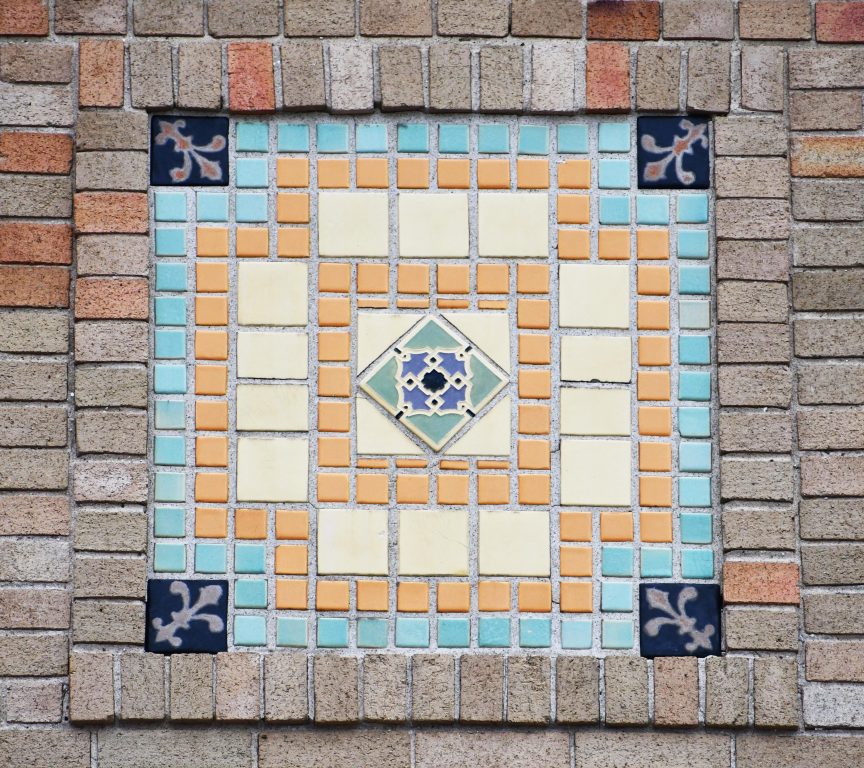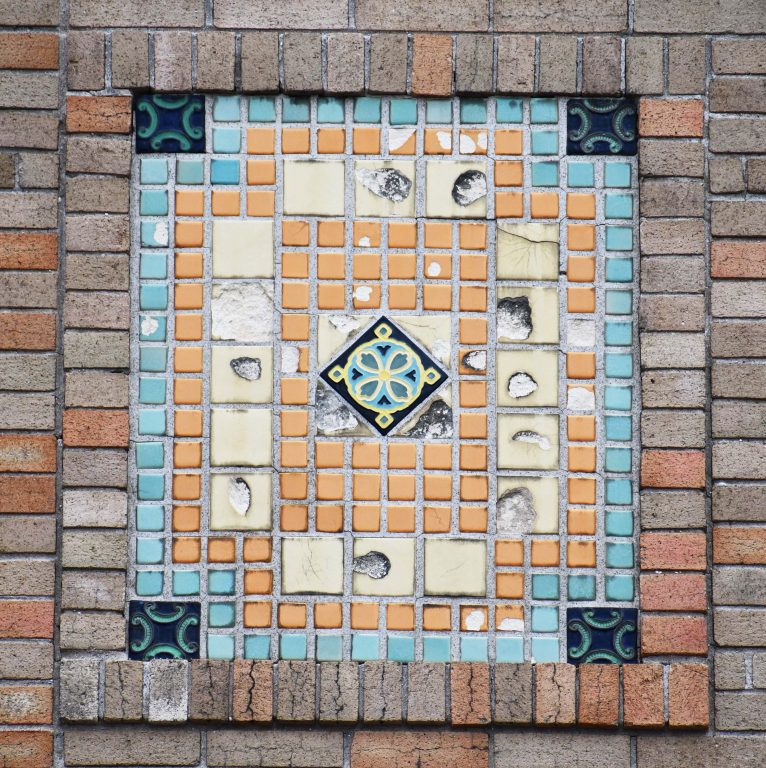Avalon Theater Tiles Romanticize Southern California
Arts & Crafts tiles evoke a mystical legend and Spanish-California styles.

The elegant façade of the Avalon Theater on Milwaukee’s Kinnickinnic Avenue in the Bay View neighborhood. Photo by Ben Tyjeski.
Many theaters from the 1920s were named Avalon, but few if any of them match the architectural caliber that the Avalon on Kinnickinnic Avenue boasts. Designed as an atmospheric theater, its decorative elements were intended to transport patrons to another time and place. This aspiration is immediately visible on the façade. Sumptuous ornamentation in textured stone, soothing shades of warm colored bricks, and clay tile roofs give you the feeling of a palatial Spanish Baroque residence. In addition are panels of faience art tiles that burst with color.
The tiles on the façade of the Avalon are part of a larger trend during the 1920s of constructing buildings in this style and using Arts & Crafts tiles to add visual interest to brick walls that, to their standards, were otherwise plain.

The floor tiles in the front lobby have been replaced with interesting decoratively shaped tiles, but the original quarry tiles are still on the base of the walls and along the skirts of the grand staircase. Photo by Ben Tyjeski.
These tiles were also purposeful in completing that vision of an imposing Spanish-styled building that enticed patrons to believe that they were approaching a portal to another place and time like 18th century Spain, or perhaps somewhere closer such as southern California.
This idea of escape was further enhanced by the name Avalon, which is based on a mystical place in the legends of King Arthur, offering a healing paradise to those who need it. While this name is ideal for an entertainment refuge, there is actually a real Avalon. Instead of on the western shores of Wales, though, it is found off the coast of Los Angeles, the only city in a place called Santa Catalina Island.
With ambitions as a destination town beginning in 1887, business began to boom after a popular jazz song called Avalon in 1920 helped draw tourists to its island. Chewing gum industrialist William Wrigley Jr. also took interest in the island, investing in the construction of buildings that romanticized the Spanish and Mission styles of architecture. He even founded the Catalina Clay Products in 1927, which manufactured colorful tiles for the island and to further attract tourists.
One of Wrigley’s buildings, the impressive Catalina Casino Building located in the city of Avalon, was built concurrently with the Avalon Theater in Milwaukee, both opening in May 1929 and both having similar design elements, including tiles.
Hence, whether the fantasy is escaping to the shores of California or the Mediterranean, faience tiles played an essential role in this architectural ensemble that hinted at traveling to some place far away when at the Avalon in Milwaukee. It would have been too incredible if the tiles on the Avalon Theater came from the Catalina Clay Products. Instead, the tiles on the façade are a mixture of Claycraft Potteries from L.A. and American Encaustic Tiling Co. from Zanesville, Ohio.
Although they are difficult to see from the sidewalk, photographed in this article are three panels that have 6-inch tiles from Claycraft Potteries in the center. They are designs no. 1412 and 1413, and were created in the raised-line technique also known as cuenca tiles, meaning that the raised lines of the tile design formed little reservoirs or “basins” which is the word cuenca in Spanish. These areas could then be filled in with glaze and allow greater control of the glaze material during the application and firing processes.

One of two panels on the façade of the Avalon Theater featuring Claycraft tile no. 1412 in the center. Photo by Ben Tyjeski.
Claycraft tiles are not common in Milwaukee’s built landscape, at least to the public eye. Several homes found throughout the metropolitan area have substantial fireplace mantels with Claycraft tiles, but this is a small niche, namely among bungalows and wealthier residential properties.

Another panel on the façade of the Avalon Theater featuring Claycraft tile no. 1413 in the center. Photo by Ben Tyjeski.
In addition to the Claycraft tiles on the Avalon are fleur-de-lis tiles from the American Encaustic Tiling Co., who was one of the leading tile manufacturers in the late 19th and 20th centuries.
The pastel-colored field tiles that surrounded the decorative inserts on the panels are slightly damaged, exposing much of the clay body underneath the glaze. This problem was likely due to the tiles not being fired to a high enough temperature. As a consequence, they are not as vitrified and are more porous. The more vitrified a tile is, the better it resists moisture and the more durability it has to stand up against the elements. It is unknown where these tiles come from.
This superficial damage, however, is meaningless when considering the unwavering wildfires that are devastating California at the present. The romanticized architecture of the West Coast is difficult to dream about when the people living there are seeing their livelihoods up in flames. Hopefully the smoke clears soon, and our California friends can rebuild their designs that have captivated so many for well over a century.

Existing members must be signed in to see the interactive map. Sign in.
If you think stories like this are important, become a member of Urban Milwaukee and help support real, independent journalism. Plus you get some cool added benefits.





















